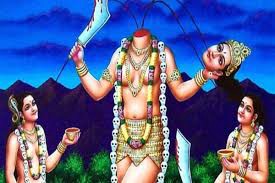Goddess Chinnamasta - pray to conquer lust
The sixth of the Dasa Mahavidyas, is the most awe inspiring Devata. Not only in Hindu Tantra but Chinnamastā finds herself prominent in the pantheon of Tibetan Tantric deities as Vajravairochani. Her stunningly ferocious imagery naturally invokes fear and trepidation, matched only by the effects that her sadhana can cause to a seeker. In Tibetan Buddhism , She is also referred to as Chinnamunda, who, some scholars believe is a form of Vajravarahi. The term vajra denotes an indestructible purity and is often added as a prefix to the names of different spiritual beings. One of the earliest texts which mention Chinnamasta is the Hindu Chinnamastākalpa and the Tantrasara.
A less ambitious application of Chinnamastā sadhana is for nullifying the effects of Rahu as a graha. Probably the most important center of Chinnamastā worship in India exists in Rajarappa in the state of Jharkhand where the idol is made of Gomedh.
The two small goddess on either side represents the iccha shakti(desire) and kriya shakti(energy to do). The goddess in middle chinnamasta is gyana shakti-the severed head represents only when the thinking of head(mind) is severed. She dances on the rathi-manmatha(god of love). The lower chakra(muladhara) raises to sahasrara. The gyana or knowledge flows from Sushumna to shasrara(the 7th chakra). Person gets enlightened.
Chinnamasta is also subtle representation of trishul. In trishul the icha and kriya shakti are bent on both side. Icha and kriya always has limitation. Only the center in trident (point upward), shows gyana shakti alone reaches to the top.
The typical figure of the Goddess has depicted her in a posture, having cut off her own head and holding it in one of her hands. From her neck erupts three streams of blood which is eagerly consumed by her attendants on two sides, ḍākinī and varini. The third stream goes into her own severed head which she holds in her left hand. Her other hand holds a khadga, and oftentimes she has a blue-lotus in her heart. However, this lends itself to a less strenuous and more comprehensive explanation that the three bloodstreams symbolized the three fundamental ethereal nerves inside the subtle body – ida, pingla and sushumna. While ida and pingla are important for balancing and controlling our daily psychology, Kundalini passing through the sushumna comes into play when a first contact with another worldly spiritual atmosphere is made ,such that our sense of reality starts changing, hopefully for the better. But what about the severed head? The journey of the Kundalini is meant to continue until it reaches the top of the head and merges into the sahasraara. Given the abruptness and exceptional danger involved in the process, very, very few people really have the nerves needed to experience or perform a successful sadhana of this form. No wonder the Tantrasara calls her Prachanda Chandika (Chandi herself being fierce, Prachanda Chandika is super fierce, as well as Sarvasiddhi – who grants all the ten siddhis, Anima, Lagima, Mahima, Ishithvam, Vasithvam, Prakamyam, Bukthi, Ichaa, Prapthi and Sarvakamam } . The Sadhanamala describes her as sarvabuddhi – complete intelligence, or enlightened intelligence. Celibacy is of great importance, at least during the initial phases, for the practice to succeed and cause no harm to the practitioner.
Some Upasak try to pray to the feet where she is dancing on rathi-manmatha (god of love) to acquire the power of lust. However saints warn such upasak she finally destroys those upasak who pray for power of lust.
Only an upasak who concentrates on her Sushumna nadi(middle blood stream which enters severed head). The upasak gets moksha(conquers the lust).
Chinnamasta is related to sun or fire, of a solar disposition. Vajra is not just a thunderbolt but also something adamantine or impenetrable. Vajravairochani is the force of an adamantine, inexhaustible fire. This etymology has led many sadhaka-scholars to speculate that this Mahavidya is best experienced when the Kundalini – which is often equated with subtle fire – awakens with a deadly force from the manipura chakra at the solar plexus of the body.
Chinnamastā sadhanas, given the extremely ferocious nature of the deity, are most often used to bring about destruction of ones enemies. Sadhaks have recorded the effects that this deity has on the mind, creating, in some cases, a great sense of fear, and then teaching the practitioner to overcome that fear.
By
V & RR
The Enlightened Souls


